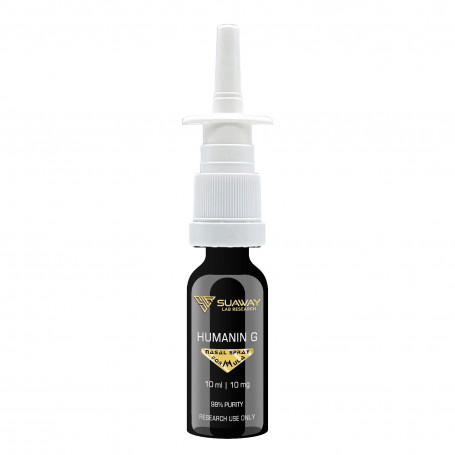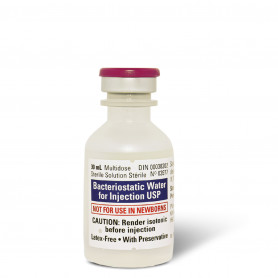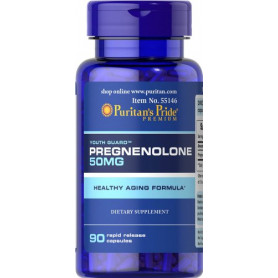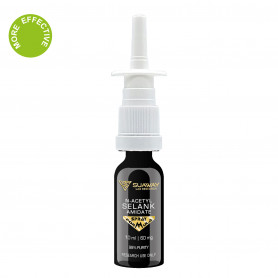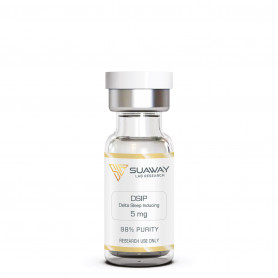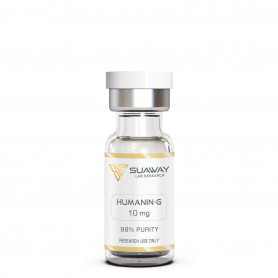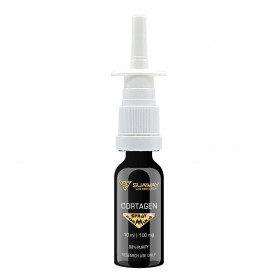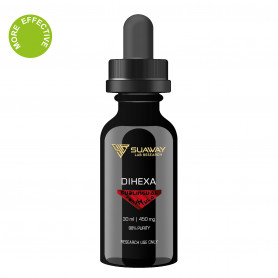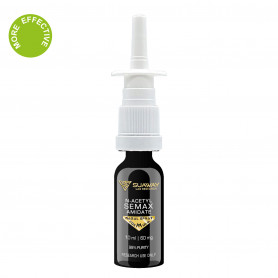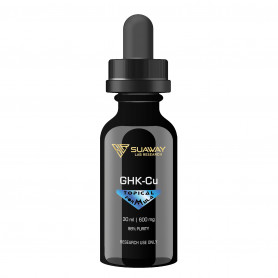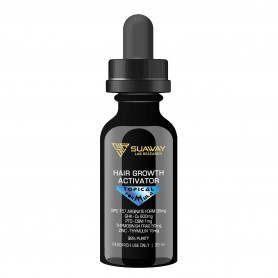HUMANIN G - 10ml/10mg
Each of the 24 amino acids in the Humanin peptide have a specific function. Serine at position 14 confers neuroprotection, but its substitution with glycine generates a variant called Humanin G (HNG) that is 1000-fold more potent than its parent analog Humanin. HNG is known to protect against cell death by preventing mitochondrial dysfunction.
Humanin-G has shown to play a vital role in the inhibition of diseases such as ischemia and Alzheimer’s, in addition to various other health benefits including prevention of cellular apoptosis, increased longevity, and reduced insulin resistance.
Total Spray: 82 (122 mcg per spray)
FRESHLY PREPARED SOLUTION
Description
STRUCTURE
HNG (Humanin-G) is an analog of Humanin, generated by S14G (serine-14-glycine)
Sequence: H-Met-Ala-Pro-Arg-Gly-Phe-Ser-Cys-Leu-Leu-Leu-Leu-Thr-Gly-Glu-Ile-Asp-Leu-Pro-Val-Lys-Arg-Arg-Ala-O H
Molecular Formula: C118H202N34O31S2
Molecular Weight: 2657,3
CAS: 330936-70-4
Peptide Purity: Greater than 98%.
Other details: No TFA Salt, No Mannitol
Storage: This product must be stored at 4°C. No suitable for freezing
DESCRITPION
Humanin, also known as HN, is a short cytoprotective polypeptide that is generated from mitochondria and is encoded by mt DNA. Through the regulation of various signaling mechanisms, such as the JAK/STAT pathway and the interaction of BCL-2 family proteins, HN can exert protective effects in various cell types, such as leukocytes, sperm cells, neurons, and tissues against cell membrane stress conditions and apoptosis. These effects can be seen in leukocytes. Within the human body, the cytoprotective peptide known as HN is a crucial component that regulates the functioning of mitochondria when they are subjected to stress.
The purpose of this review is to investigate the antiapoptotic properties of HN peptide as a possible therapeutic target for the treatment of a variety of disorders, including cancer, diabetes mellitus, reduced fertility, bone-related diseases, cardiac diseases, and brain diseases. According to research conducted in vitro and in vivo, HN effectively inhibited apoptosis during the treatment of osteoporosis, cardiovascular illnesses, diabetes mellitus, and neurological diseases. According to the accumulated data, it has been determined that HN is responsible for the proapoptotic activity of TNF-α in cancer. This identifies HN as a novel therapeutic agent that can be used in the treatment of cancer. It has also been suggested that, in addition to HN, the advancement of another akt peptide may be a viable treatment target against various diseases related to oxidative stress and apoptosis.
In contrast to regular peptides and proteins,micro-peptides are produced by short, open reading frames (sORFs) and do not undergo modification once they are produced. Their roles range from facilitating the processing of messenger RNA (mRNA) to assisting in the repair of damaged DNA to collaborating with the other proteins to form more complicated macro proteins. The length of Humanin, one of the shortest micro-peptides that have been discovered to date, is just 24 amino acids. To regulate apoptosis, it engages in interactions with the Bcl2-associated X protein (Bax), inhibiting the function of Bax when this is required to maintain cells that would have been killed otherwise.
According to the findings of several studies, Humanin offers protection not only against apoptosis but also against the death of programmed cells under certain conditions. In particular, it has been demonstrated that the micro-peptide can protect cells in the presence of Alzheimer's disease by avoiding the death of cells that would otherwise be caused by the accumulation of beta-amyloid plaque.
Humanin appears to safeguard neurons through two distinct methods, each of which has the ultimate purpose of blocking mitochondria from triggering the apoptotic pathway. Humanin appears to safeguard cells in these ways. Under typical conditions, proteins belonging to the Bcl-2 family send a signal to trigger the release of other proteins from the mitochondria. These proteins, in turn, activate caspases, which are responsible for ensuring the systematic breakdown and recycling of a cell. This procedure is really helpful in a variety of contexts, such as during a viral incursion, when the elimination of a few cells can prevent extensive tissue damage. Unfortuitously, the process may become dysregulated in certain illness states, leading to uncontrolled and widespread cell death as a result. Since Humanin binds to the Bcl-2 boosting proteins Bid thus tBid and inhibits the action of these proteins, it can stop the apoptotic process right at its beginning.
Research that is considered to be cutting edge came from Argentina and discovered that Humanin is secreted by astrocytes to protect synapses in hippocampus neurons. Some researchers believe that the function of Humanin may deteriorate with age, similar to the way that many naturally occurring regulatory mechanisms do. This would make it possible for age-related memory loss as well as an increasing prevalence of neurodegenerative illness. Some studies believe that there may be a use for Humanin supplements in older persons and that it may provide a means of mitigating the normal reductions in the production of this essential micro peptide that is associated with aging.
A study that was conducted at the Mayo Clinic, which is widely regarded as the best medical facility in the United States, found that Humanin has been expressed in the wall surfaces of the human vascular system and contributes to the protection of blood vessels against the effects of oxidized LDL cholesterol. In particular, Humanin acts as an inhibitor of the generation of reactive oxygen species, also known as free radicals, which is caused by the oxidation of LDL. In doing so, it brings about a reduction of reactive oxygen molecules in the vascular by a factor of 50% and also brings about a reduction of apoptosis by a factor of 50%.
AMD, which stands for age-related macular degeneration, is a debilitating retinal condition that ranks among the top causes of irreversible blindness around the world. Drusen deposits accumulate between Bruch's membrane and the retinal pigment epithelium (RPE) in the early stages of age-related macular degeneration, which is a pathological manifestation of the disease. In advanced stages, the disease can be identified by severe RPE degeneration, in addition to the loss of photoreceptors (geographic atrophy), and/or choroidal neovascularization. New research suggests that Humanin is an essential component of the RPE and that it helps reduce oxidative stress in this tissue. When supplemented with Humanin in cell culture, RPE function is improved, and the tissue's resistance to apoptosis is increased. There is reason to believe that this could be of assistance to researchers in developing more effective treatments and preventative measures for retinal illnesses such as macular degeneration.
Researchers in Sweden & Korea have independently discovered that there may be two distinct ways in which Humanin is advantageous to bone health. First, it has been discovered that the micro-peptide can prevent the death of chondrocytes, which are the cells that generate the collagen matrix on which bone is built, without interfering with the anti-inflammatory actions of glucocorticoids such as dexamethasone. Because of this effect, the rates at which bone and cartilage are growing are increased, which helps to offset some of the increased bone loss that is induced by glucocorticoids. Humanin appears to inhibit the creation of osteoclasts while at the same time encouraging the development of chondrocytes. Osteocytes are the cells that are responsible for the process of remodeling and breaking down bone. The overactivation of these cells during pathologic situations results in severe bone loss, even though they are helpful and vital in normal physiologic function. Humanin serves to prevent the production of osteoclasts, which contributes to a reduction in excessive bone remodeling and loss.
Because it is constantly exposed to UV radiation, the skin is a target of oxidative damage continually. It is widely believed that oxidative stress plays a significant part in several dermatological conditions, including psoriasis. The purpose of this research was to investigate the significance of Humanin analog (S14-G HNG) as an anti-oxidant for the psoriasis-like condition that has been observed in BALB/c mice as of this date. Corticosteroids are the medications that are most commonly used to treat this disease, even though their adverse impact profile in terms of chronic use is unsatisfactory.
The following conditions are associated with low Humanin levels:
- Alzheimer's disease
- Mitochondrial dysfunction
- Aging
- Stress response
- Vascular dysfunction
- Diabetes
- Insulin resistance
- Vision loss
All the advantages of using Humanin-G are as follows:
- Protects cells from oxidative stress
- Induces Mitochondrial Biogenesis (the growth of new mitochondria)
- May contribute to longer longevity
- Cardioprotective
- Improves cell survival by binding tyrosine kinases
- Increases production of energy (ATP)
- Improves cell survival by binding to and inhibiting by Insulin-Like Growth Factor Binding Protein-3(IGFBP-3) and Bcl2-Associated X protein (Bax)
- Can enhance cell survival by attaching to and deactivating proapoptotic Coiled - coil proteins such as tBid and ELBI (BimEL)
- Activate ERK1/2 and JAK2-STAT3
- Activate PI3K/Akt (helps with stroke)
- Controls cell apoptosis, metabolism, as well as transcription
- Lowering inflammation
- Degrading atherosclerotic plaques
- Increasing insulin sensitivity
- Inhibiting cell death
- Enhance Brain Aβ Clearance
- Ameliorates Alzehiemer's Disease And Improves Short-Term Memory
- Suppressing hypoxia
HN can protect brain cells against Amyloid-Beta (AB)-induced cell death and increase clearance AB levels, a common pathology seen Alzheimer's Disease (AD). It can also protect the brain against Tau Hyperphosphorylation (a pathology of AD).
HNG taken intranasally can reduces AB accumulation and ameliorates memory deficit in AD animal models. HNG may protect against Insulin Resistance (IR) in the brain, a main pathology of Type 3 Alzheimer's/Diabetes. For example, by stimulating STAT3 and inhibiting IGFBP3 in the hypothalamus, HNG is a powerful insulin sensitizer and may help with IR in AD.
REFERENCES
M. Matsuoka "Humanin; a defender against Alzheimer's disease?" [PubMed]
Seon-Yong Jeong et al., "The role of mitochondria in apoptosis" [PubMed]
J. Xiao et al., "Humanin: Functional Interfaces with IGF-I" [PubMed]
P.G. Sreekumar et al., "The Mitochondrial-Derived Peptide Humanin Protects RPE Cells From Oxidative Stress, Senescence, and Mitochondrial Dysfunction" [ResearchGate]
A.R. Bachar et al., "Humanin is expressed in human vascular walls and has a cytoprotective effect against oxidized LDL-induced oxidative stress" [PubMed]
S. Nashine et al., "Humanin G (HNG) protects age-related macular degeneration (AMD) transmitochondrial ARPE-19 cybrids from mitochondrial and cellular damage" [PMC]
Z. Salahuddin et al., "Revolutionalizing the age old conventional treatment of psoriasis: An animal based comparative study between methylprednisolone and different doses of a novel anti-oxidant humanin analogue (HNG)" [ScienceDirect]
N. Kang et al., "Humanin suppresses receptor activator of nuclear factor-κB ligand-induced osteoclast differentiation via AMP-activated protein kinase activation" [PubMed]
A. Zhloba et al., "The level of circulating humanin in patients with ischemic heart disease" [PubMed]
D. Zhai "Humanin binds and nullifies Bid activity by blocking its activation of Bax and Bak" [PubMed]
I. Sponne et al., "Humanin rescues cortical neurons from prion-peptide-induced apoptosis" [PubMed]
S.C. Zàrate et al., "Humanin, a Mitochondrial-Derived Peptide Released by Astrocytes, Prevents Synapse Loss in Hippocampal Neurons" [PubMed]
A.R. White et al., "Sublethal concentrations of prion peptide PrP106-126 or the amyloid beta peptide of Alzheimer's disease activates expression of proapoptotic markers in primary cortical neurons" [PubMed]
DISCLAIMER
This product is intendend for lab research and development use only. These studies are performed outside of the body. This product is not medicines or drugs and has not been approved by the FDA or EMA to prevent, treat or cure any medical condition, ailment or disease. Bodily introduction of any kind into humans or animals is strictly forbidden by law. This product should only be handled by licensed, qualified professionals.
All product information provided on this website is for informational and educational purposes only.

